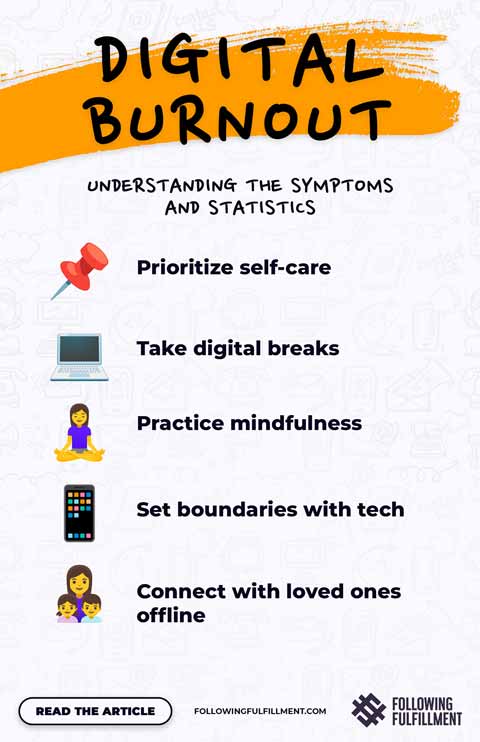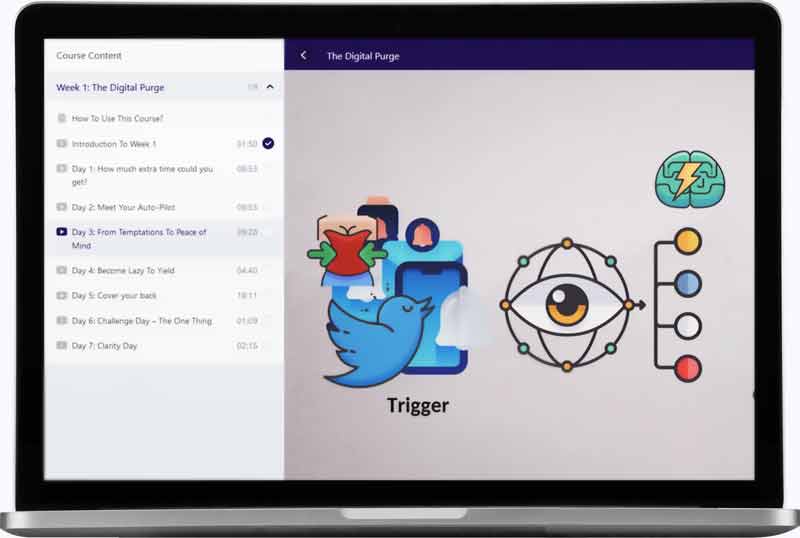- What is a Digital Burnout?
- Statistics on Digital Burnout
- Causes and Factors Contributing to Digital Burnout
- Preventing and Combating Digital Burnout
- Empowering Yourself in the Digital Age
- Conclusion: Navigating Digital Burnout with Resilience

What is a Digital Burnout?

In this digital age, our lives revolve around screens, devices, and constant connectivity. While technology has undoubtedly made our lives easier, it has also led to a new phenomenon known as digital burnout. Digital burnout is a state of mental and physical exhaustion caused by overuse and dependence on technology. In this section, we will explore what digital burnout is, its symptoms, and how it affects our personal and professional lives.
Digital Burnout Meaning and Definition
Digital burnout refers to the state of exhaustion and stress caused by excessive use of digital devices and technology. It is a result of over-engagement with technology, such as spending long hours on social media, emails, or other digital platforms. This constant exposure to technology can lead to physical and mental fatigue, affecting productivity, creativity, and overall well-being. Symptoms of digital burnout include lack of focus, decreased motivation, irritability, and insomnia. To prevent digital burnout, it is important to take breaks from technology, set boundaries for device use, prioritize self-care, and engage in activities that do not involve screens. Digital detox programs and mindfulness practices can also be helpful in reducing the negative effects of digital burnout.
Digital Burnout Symptoms: Signs to Watch Out For
Digital burnout is a growing concern, especially among those who spend a lot of time on digital devices. Here are some common symptoms of digital burnout to watch out for:
– Insomnia or difficulty sleeping
– Eye strain and headaches
– Neck and back pain
– Depression or anxiety
– Irritability and mood swings
– Difficulty concentrating
– Decreased productivity
– Social withdrawal or isolation
If you experience any of these symptoms, it may be time to take a break from digital devices and practice digital detox. This can include setting boundaries with technology use, taking regular breaks, engaging in non-digital activities, and finding ways to manage stress.
Statistics on Digital Burnout

In this digital age, our lives revolve around screens, devices, and constant connectivity. While technology has undoubtedly made our lives easier, it has also led to a new phenomenon known as digital burnout. Digital burnout is a state of mental and physical exhaustion caused by overuse and dependence on technology. In this section, we will explore what digital burnout is, its symptoms, and how it affects our personal and professional lives.
Insights into the Prevalence of Digital Burnout
Digital burnout is becoming increasingly prevalent in today’s society due to the overuse of technology. Studies have shown that excessive use of digital devices can lead to physical and mental exhaustion, resulting in a decrease in productivity and overall well-being. The constant need to check emails, notifications, and messages can also lead to a lack of focus, decreased attention span, and increased stress levels. It is important to recognize the signs of digital burnout and take steps to prevent it, such as setting boundaries for technology use, taking breaks from screens, and engaging in other activities that promote relaxation and mindfulness. Ultimately, finding a healthy balance between technology use and offline activities is key to avoiding digital burnout and improving overall well-being.
Digital Burnout Research: Key Findings
According to recent research, digital burnout is on the rise due to the constant use of technology and social media. The study found that the average American spends around 11 hours per day using digital devices, which can lead to feelings of exhaustion, stress, and anxiety. Furthermore, being constantly connected can blur the lines between work and personal life, leading to a lack of work-life balance. Symptoms of digital burnout can include difficulty focusing, insomnia, and decreased productivity. However, taking a digital detox can help alleviate these symptoms by reducing screen time and promoting mindfulness and relaxation. Disconnecting from technology for even a short period can help individuals recharge and improve their overall well-being.
Causes and Factors Contributing to Digital Burnout

In this digital age, our lives revolve around screens, devices, and constant connectivity. While technology has undoubtedly made our lives easier, it has also led to a new phenomenon known as digital burnout. Digital burnout is a state of mental and physical exhaustion caused by overuse and dependence on technology. In this section, we will explore what digital burnout is, its symptoms, and how it affects our personal and professional lives.
Burnout in Digital Marketing: Challenges and Solutions
One of the biggest challenges faced by digital marketers is burnout. The constantly connected nature of the job can lead to exhaustion and decreased productivity. However, there are solutions to combat burnout and maintain a healthy work-life balance. One solution is to implement a digital detox by setting clear boundaries for work and personal time. This can include limiting after-work emails and notifications, taking breaks throughout the day, and disconnecting from technology during non-work hours. Another solution is to prioritize self-care through activities such as exercise, meditation, and spending time with loved ones. Additionally, seeking support from colleagues, friends, or a therapist can help alleviate stress and prevent burnout. By prioritizing self-care and implementing a digital detox, digital marketers can maintain their well-being and productivity in the fast-paced world of digital marketing.
Understanding Digital Nomad Burnout
Digital nomad burnout is a type of stress that results from a prolonged period of working remotely and living a nomadic lifestyle. It is characterized by physical, emotional, and mental exhaustion, loss of motivation, and decreased productivity. Factors that contribute to digital nomad burnout include social isolation, lack of routine, constant travel, and the pressure to always be connected and productive. To prevent digital nomad burnout, it is important to establish a routine, set boundaries, prioritize self-care, and find a support system. Taking breaks from work, practicing mindfulness, and engaging in physical exercise can also help to alleviate stress and prevent burnout. It is important to remember that burnout is a real and serious issue that can have long-term effects on mental and physical health, and taking steps to prevent it is essential for maintaining a healthy and sustainable digital nomad lifestyle.
The Impact of Digital Burnout at Work
Digital burnout at work can have a significant impact on an individual’s physical and mental health, as well as their productivity and job satisfaction. Constant exposure to digital devices and notifications can lead to increased stress levels, sleep disturbances, and eye strain. This can result in reduced focus and concentration, increased errors and mistakes, and decreased motivation and engagement with work tasks. Additionally, digital burnout can lead to feelings of overwhelm and negatively impact an individual’s ability to prioritize tasks effectively. To combat digital burnout, it is important to set boundaries and limit the amount of time spent on digital devices, take regular breaks throughout the day, and disconnect completely during non-work hours to allow for rest and rejuvenation. Employers can also support their employees by promoting work-life balance and providing resources for stress management and mindfulness practices.
Preventing and Combating Digital Burnout

In this digital age, our lives revolve around screens, devices, and constant connectivity. While technology has undoubtedly made our lives easier, it has also led to a new phenomenon known as digital burnout. Digital burnout is a state of mental and physical exhaustion caused by overuse and dependence on technology. In this section, we will explore what digital burnout is, its symptoms, and how it affects our personal and professional lives.
Digital Detox for Tech Burnout: Reclaiming Balance
Digital detox is a process of taking a break from technology that aims to reduce stress, improve mental health, and increase productivity. It involves setting boundaries for device usage and taking conscious steps to disconnect from the digital world. This can be done by turning off notifications, limiting screen time, and engaging in offline activities such as reading, exercising, or spending time with family and friends. By unplugging from technology, individuals can recharge, refocus, and gain a better perspective on their priorities and goals. It is important to prioritize self-care and establish healthy digital habits to avoid burnout and maintain a balanced lifestyle.
Digital Burnout Prevention Strategies
1. Set boundaries: Decide on specific times when you will disconnect from technology, such as during meals or before bed.2. Take breaks: Incorporate short breaks throughout your day to give your brain a chance to recharge and prevent burnout.3. Prioritize self-care: Make time for activities that promote relaxation and reduce stress, such as exercise, meditation, or spending time in nature.4. Limit screen time: Set limits on the amount of time you spend on your devices each day and try to stick to them.5. Unplug on weekends: Consider taking a break from technology entirely on the weekends to recharge and reset.6. Use productivity tools: Explore apps or tools that can help you manage your time and reduce distractions.7. Seek support: Don’t be afraid to reach out to friends, family, or a mental health professional if you are struggling with digital burnout.
Empowering Yourself in the Digital Age

In this digital age, our lives revolve around screens, devices, and constant connectivity. While technology has undoubtedly made our lives easier, it has also led to a new phenomenon known as digital burnout. Digital burnout is a state of mental and physical exhaustion caused by overuse and dependence on technology. In this section, we will explore what digital burnout is, its symptoms, and how it affects our personal and professional lives.
Digital Minimalism: An RX for Clinician Burnout
Digital minimalism is an effective remedy for clinician burnout caused by over-reliance on technology. Clinicians can reduce their screen time and focus on face-to-face interactions with patients. They can also limit the use of electronic devices during personal time and engage in activities such as reading, exercise, and socializing. Digital minimalism enhances cognitive function, improves creativity, and promotes mental clarity. Clinicians should also consider implementing digital boundaries by turning off notifications and establishing specific times for checking emails and messages. By adopting digital minimalism, clinicians can reduce stress and improve their overall well-being, which ultimately leads to better patient care.
Reclaiming Control: Tips for Managing Digital Overwhelm
In our hyper-connected world, it’s easy to feel overwhelmed by the constant stream of information and notifications. To manage digital overwhelm, start by setting boundaries for your technology use. This could mean scheduling specific times to check email and social media, turning off notifications for non-essential apps, and designating tech-free zones in your home or workplace.
Additionally, try to prioritize your digital activities and focus on what’s most important. If you find yourself mindlessly scrolling through social media, try setting a specific goal or purpose for your time online.
Finally, make time for activities that don’t involve technology, such as reading, exercising, or spending time in nature. By taking breaks from technology and focusing on other aspects of your life, you can reclaim control and reduce digital overwhelm.
